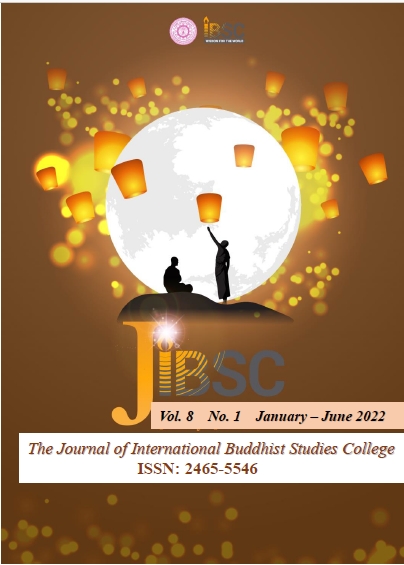THe Way to Maintain Equanimity through Cultivating the Noble Eightfold Path
Main Article Content
Abstract
The research objectives were to study the concept of the noble eightfold path and the ten kinds of equanimity (upekkhā) in Theravada Buddhism, including their interrelation and the manner in which they support each other. Furthermore, the objective was to propose a method for maintaining equanimity through the cultivation of the noble eightfold path. Seven experts in Buddhism were selected for in-depth interviews. The research instrument for the collection of data is in the form of questionnaires, which also serve as the basis for in-depth interviews. The data were analysed using a content analysis method.
The research findings revealed that the noble eightfold path, which is specifically focused on threefold trainings (traisikkhā), and the ten kinds of equanimity (upekkhā) are interrelated and mutually supportive in their overall structure. It can be concluded that the three principal forms of equanimity (upekkhā) are significantly interrelated and support the noble eightfold path. These are (1) the six-fold equanimity of an Arahant towards objects of the six senses (Chalangupekkhā), (2) equanimity as the last of the four divine abodes (Brahmavihārubekkhā), and (3) equanimity as a type of feeling (Vedanupekkhā). Conversely, the three principal aspects of the noble eightfold path (1) right effort, (2) right concentration, and (3) right view were found to be significantly interrelated and supportive of equanimity.
The study concludes that maintaining equanimity through the Noble Eightfold Path can be effectively summarized in three dimensions: (1) bodily equanimity achieved by avoiding wrongful actions, (2) verbal equanimity maintained by refraining from false speech, and (3) mental equanimity preserved by steering clear of incorrect thoughts. Future studies could explore the practical application of these findings in different cultural contexts and among various Buddhist traditions. Additionally, examining how the integration of the Noble Eightfold Path and equanimity influences psychological well-being and daily life practices could provide further insights into their efficacy. Implementing longitudinal studies could also help assess the long-term impact of cultivating equanimity through the Noble Eightfold Path on overall mental health and stability.
Article Details
The Journal of TCI is licensed under a Creative Commons Attribution-NonCommercial-NoDerivatives 4.0 International (CC BY-NC-ND 4.0) licence unless otherwise stated. Please read our Policies page for more information on Open Access, copyright and permissions.
References
Bannaruji, Banjob, and Sanu Mahatthanadull. "An Analytical Study of the Four Noble Truths in Theravāda Buddhism." The Journal of the International Association of Buddhist Universities 11, no. 1 (2018): 147-160.
Buddhadasa Bhikkhu. Path of Periscope. Bangkok: Dhammasat University, 1997
Buddhaghosa. Visuddhimagga (The Path of Purification) (Vism I 350. Translated by Ñanamoli (Tr.). W.A.: Buddhist Publication Society, 2013.
Chansomsak, Sant, and Brenda Vale. “The Buddhist approach to education: An alternative approach for sustainable education.” Asia Pacific Journal of Education. Vol. 28, No. 1 (2008): 35-50.
D.Litt., Woodwarad F.L.and Mrs. Rhys Davids. 1995. Gradual Sayings (Aṅguttara Nikāya), vol. I. Oxford: PTS
Gunaratana, Henepola. A critical analysis of the Jhanas in Theravada Buddhist meditation. American University, 1980.
Irons, Edward A. Encyclopedia of Buddhism. Facts on File, 2008.
Johnson, Ian. “The application of Buddhist principles to lifelong learning.” International Journal of Lifelong Education. Vol. 21, No. 2 (2002): 99-114
Klangtepdarunānusitta, Davi Dhamadhaj. Dhātutīpikā: Pali-Thai dictionary. Bangkok: Mahāmakut Buddhist University Printing, 1997.
Kuppako, Decha. “Buddhism in Thai life: Thai model for ASEAN” Mahachula Academic Journal. Vol. 3, No. 1 (2016): 138-158.
Munindho, Venerable Phramaha Somphaung. Abhidhāvannā Buddhist Scripture. Bangkok: Dhammasabhā Printing, 1999.
Murphy, Anne. “The Ten Kinds of Equanimity (Upekkhā)”. ColomboArts Journal of Social Sciences and Humanities, Volume II. (Issue 2, 2017): 18-30.
Nanamoli Bhikkhu, and Bhadantacariya Buddhaghosa. “Visuddhimagga: The path of purification.” (2003): 950.
Phra Brahmagunabhorn (P.A. Payutto). Buddhadhamma Expanded Volume. Bangkok: Sahadhammik Press, 2016.


